

Le notizie storiche relative al territorio di Brolo si possono ricavare dalla ricostruzione della Tabula Peuntingeriana (documento in cui sono riportate le antiche vie di Roma) in cui è riportata la viabilità della Sicilia del IV secolo. Da essa si desume che la Via Valeria attraversava la Sicilia da oriente ad occidente estendendosi dallo Stretto di Messina a Capo Lilibeo, attraversando il centro urbano di Brolo, seguendo l’attuale S.S. 113, e veniva utilizzata per gli scambi commerciali dell’epoca.
Uggeri, in “La Sicilia nella Tabula Peuntingeriana” scrive relativamente alla Via Valeria: «Questo percorso, noto nel Medioevo come h basilich odoz (doc. a. 1091), è pedemontano da Tindàro verso Sant'Agata di Militello, scavalcando il Capo Calavà e poi per Gioiosa Marea, Brolo, San Carrà, Scafa, San Martino e Rocca (dove si stacca una variante costiera recenziore per Sant'Agata)».
Ma il borgo ha fondalmentalmente un origine medioevale e nasce e si sviluppa intorno al castello, costruito durante il periodo normanno quasi a picco sul mare dominava il tratto di costa circostante ed era posto a difesa delle spiagge sottostanti.
Il castello, unitamente al villaggio di pescatori era conosciuto originariamente con il termine Voab, derivato dalla precedente dominazione araba e che significa “Rocca Marina”, da cui si può evincere l’importanza dello stesso per le vicine località di Capo d’Orlando e Capo Calavà; Brolo possedeva un porto, segnalato dal geografo Edrisi nel 1154 con il nome di Marsa Daliah e probabilmente presentava in origine una costruzione per l’avvistamento delle navi saracene.
Pur non avendo notizie certe sui fondatori del primo insediamento, le fonti storiche lo fanno risalire all’XI secolo e le attribuiscono alla nobile famiglia dei Primati, appartenente al ceppo di Bartolomeo d’Aragona e legata alla corte di Federico II. Le origini del toponimo “Bro(g)ilos”, cioè “giardino, frutteto, luogo recitato” è gallo-italica, nome molto diffuso nell’area lombardo-veneta. La giurisdizione del feudo venne poi concessa alla famiglia dei principi Lancia che lo governò fino al XIII secolo. Lo sviluppo dell’abitato avvenne gradualmente: dapprima nel XVII secolo vi fu lo sviluppo della pianura sotto il castello, intorno alla chiesa madre, dopo, lungo la strada regia, furono costruiti i palazzetti ottocenteschi. Altre famiglie che esercitarono il potere furono i marchesi Longarino e Abate. Importanti opere furono la Porta Fausa, inserita nelle mura di cinta medievali, la grotta dei Saraceni, la chiesa Madre (Maria SS. Annunziata, costruita intorno al 1764 fatta costruire da Ignazio Vincenzo Abate, marchese di Longarino e Signore di Brolo e che conserva all’interno dipinti e affreschi pregevoli). Anche i palazzi nobiliari delle famiglie Baratta, Maniaci, Gembillo, Germanà e Scaffidi che racchiudono importanti affreschi del XVII secolo. Il Castello, che sovrasta il borgo raggiungibile dalle varie viuzze che lo attraversano, era residenza di Bianca Lancia, moglie nel 1246 di Federico II che vi portò la Corte. In seguito divenne reggia anche di Manfredi, re di Sicilia nel 1258. il suo interno ospita il Museo delle fortificazioni costiere della Sicilia e il Museo delle pene e della tortura.
(English)
The historical news about the territory of Brolo can be drawn of reconstruction of the Tabula Peuntingeriana (document in which are included the ancient streets of Rome) in which is storytold the viability of Sicily in the IV century. From it, From it, it is inferred that the Via Valeria crossed Sicily from east to west, extending from the Strait of Messina to Capo Lilibeo, crossing the urban centre of Brolo, following the actual S.S. 113, and was used for trade of the time.
Uggeri, in “La Sicilia nella Tabula Peuntingeriana” write relatively to the Via Valeria: This route, known in the Middle age such “h basilich odoz” (doc. A. 1091), is piedmont from Tindàro versus Sant’Agata di Militello, passing over Capo Calavà and then for Gioiosa Marea, Brolo, San Carrà, Scafa, san Martino and Rocca (where detaches a variant coastal reviewer for Sant’Agata)>>.
But the town has substantially a medieval origin and was founded and developed around the castle, built during the Norman period almost overlooking the sea, it dominated the stretch surrounding coastline and was placed to defense of the beaches below.
The castle, together with the fishers village, is known originally with the term Voab, derived from previous Arab rule and that means “Rocca Marina” from which it can deduce the importance of same for the close locations of Capo d’Orlando and Capo Calavà; Brolo had a harbor, marked from geographer Edrisi in 1154 with the name of Marsa Daliah and probably it featured, originally, a watchtower for the Saracen boats.
Even though we have no certain news about the founders of the first settlement, the historical source it date back to the eleventh century and it attribute to the noble family of Primati, belonging of the strain of Bartolomeno d’Aragona and related to the court of Federico II. The origin of the toponym “Bro(g)ilos”, that is “garden, fruit trees, fenced place”, it is Gallo-Italic, name very popular in the Lombard-Venetian. The jurisdiction of the feud went after given to to the family of Princes Lancia that governed it until XIIIth century. The develop of the village took place gradually: firstly in the XVIIth century there were the develop in the valley under the castle, around the mother church, after, along the royal road, was built the nineteenth century buildings. Other families who exercised the power were marquises Longarino and Abate. Important works were the Porta Fausa, included in the medieval city walls, the cave of Saracens, the Mother Church (Maria SS. Annunziata, built around 1764, commissioned by Ignazio Vincenzo Abate, marquise of Longarino and ruler of Brolo and that preserve at the interior valuable paintings and frescoes). Also the noble palaces of families Baratta, Maniaci, Gembillo, Germanà and Scaffidi that contain important frescoes on the XVII century. The Castle, overlooking the village accessible by the little streets that across it, was the residence ob Bianca Lancia, wife in the 1246 of Federico II, that bring in it the Court.
Later was royal palace also of Manfredi, king of Sicily in the 1258, at the interior houses the Museo delle fortificazioni costiere della Sicilia and the Museo delle pene e della tortura.